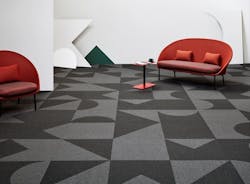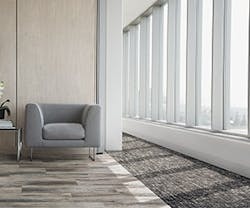Of all the design elements in a space, carpet is meant to be replaced less often. However, while flooring can easily withstand 10, 15 or even 20 years of use, major technological advancements have occurred over the years. If you’re looking into replacing the carpet in your building, this is what you need to know about the latest in flooring design.
Flooring Tiles
While broadloom—aka wall-to-wall—carpet still exists, many manufacturers are producing carpet and vinyl tiles as well. Created in a variety of shapes and sizes, carpet tiles are ideal for:
- High traffic spaces as individual tiles can be replaced rather than the whole carpet if one gets damaged
- Unique designs since the tiles can be mixed and matched—since they’re bought and installed as individual tiles, there isn’t a need for a standard look throughout the space
- Advanced wayfinding is often needed in spaces where there are different corridors a visitor would have to navigate. Companies like Mohawk Group have tiles which transition between a standardized color and pattern scheme and unique tiles (think pink or yellow) that can be used to provide optimal wayfinding
What’s more—carpet tiles allows a more toned-down pattern or color scheme to be used. Because individual stained or worn tiles can be replaced, a busy pattern isn’t necessary to mask imperfections.
12 colors to create endless unique options using floor tiles. Photo: Shaw Contract
Custom Flooring
In the design world, “printing” means something much different than just making a mark on paper. High definition printers are now available for carpet, vinyl and even tile.
Creating a custom flooring to match corporate branding through color and logos has never been easier, and it makes a statement. Branding is moving away from just a sign out front to the interior of a business’ space, giving employees and visitors an all-encompassing aesthetic.
Related: How Low Moisture Carpet Cleaning is a Green Option
Biophilia and Biomimicry
Biomimic design encompasses products like ceramic tiles that have an embossed surface pattern that borrows from the scales of reptiles and fish to keep bacteria from forming, while biophilic design would use patterning from the same scales as its basic grounding.
A great example of biophilia comes again from Mohawk Group: in 2017 it released its Lichen line that takes its color pallet and patterning from its namesake. Biophilic design has been proven to psychologically promote better wellbeing; humans weren’t created to spend nearly 93 percent of their time indoors, so introducing materials that look like wood, greenery and other natural elements has a profoundly positive impact on people’s mental wellbeing.
Sustainability Initiatives
For example, Interface recently launched its Global Change collection of modular carpet. As part of its Net Effect line, nylon waste from discarded fishing nets—one of the worst polluters in our oceans—is recycled into polymer pellets that becomes new carpet fiber.
(Photo: Interface is committed to zero emissions by 2020. Their collections, therefore, look for ways to be sustainable beyond post-consumer recycled content. Credit: Interface)
This also means that when you plan on ripping up the old carpet, make sure to contact its manufacturer to see how the end-of-life process is organized. Most will recycle the carpet for you, reusing the thread polymers to create the next line.
If the manufacturer doesn’t have a recycling process and other recycling options don’t exist in your area, Lisa Conway, vice president of sustainability for Interface Americas, suggests donating it to local animal shelters where the soft flooring can benefit the dogs and cats waiting for their forever homes.
Blurring of Lines
Advancements in technology has led to a surprising pattern in the design world: products are no longer relegated to one space or another. Corporate design is borrowing from hospitality; healthcare is looking to retail; educational spaces are working to bridge the gap between school and offices.
As long as a carpet is made with a particular foot traffic in mind, it doesn’t matter if an office is outfitted with a carpet designed for hospitality.
Two hand-picked articles to read next:
About the Author

Kadie Yale
Former Architecture & Design Expert
Kadie Yale holds a BA in Industrial Design from San Francisco State University and MA in Decorative Art History and Theory from Parsons the New School.

